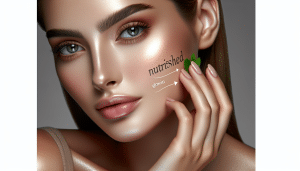You Won’t Believe These Simple Skincare Rituals
Ella Knight September 25, 2025
Curious about glowing skin? Discover evidence-based skincare rituals that anyone can integrate for visible beauty benefits. This in-depth guide weaves together effective routines, ingredient wisdom, and trends to help you unlock your skin’s natural vitality—all in language anyone can understand.
The Science Behind Glowing Skin
Having radiant skin is more than an aesthetic goal—science shows it’s tied to overall health and well-being. Hydration levels, cell turnover, and the skin barrier all impact how luminous your complexion appears. When daily routines incorporate gentle cleansing, balanced exfoliation, and thoughtful moisturization, the skin often responds beautifully. Those who prioritize these habits tend to notice smoother texture, minimized irritation, and long-term resilience (Source: https://www.ncbi.nlm.nih.gov/pmc/articles/PMC6017965/).
The skin is the body’s largest organ, acting as both shield and showcase. Environmental stressors, UV light, and urban pollutants can all disrupt its delicate balance, but a daily ritual that repairs damage and strengthens the skin barrier is key. Incorporating antioxidants—commonly found in vitamin C serums—and gentle, fragrance-free cleansers can make a big difference. Even the simple act of regular sunscreen use is proven to protect and maintain skin health (Source: https://www.aad.org/public/diseases/a-z/skin-care).
Individual skin needs can vary with age, climate, and genetics. However, dermatologists consistently recommend routines that avoid harsh scrubbing and focus on steady hydration. Niacinamide, ceramides, and hyaluronic acid are ingredients often celebrated for their naturally plumping and calming effects. It’s fascinating how small, consistent choices can support a youthful glow—proving that visible wellness is an achievable goal for most.
Everyday Skincare Rituals That Work
Cleansing twice daily, morning and night, is foundational. Gentle cleansers protect the skin’s microbiome and help remove buildup from pollution and excess oil. Double cleansing, which uses an oil-based followed by a water-based cleanser, is gaining attention for effectively breaking down sunscreen and makeup without stripping essential lipids (Source: https://www.health.harvard.edu/blog/simple-steps-to-healthy-skin-2019080617409).
Moisturizing morning and night ensures the barrier remains healthy and comforted. Creams with ceramides and fatty acids help lock in hydration while reducing inflammation. For many, integrating a few drops of facial oil can enhance softness and create a subtle glow. Layering these elements—especially after showering when the skin is slightly damp—can maximize moisture retention.
Weekly exfoliation, either with chemical exfoliants (like lactic or glycolic acid) or gentle scrubs, reveals fresher skin underneath. Over-exfoliation is a common pitfall: experts advise starting slowly and listening to the skin’s response. Moisturizing masks and overnight treatments can complement this routine, providing an opportunity for deeper repair and relaxation.
The Role of Nutrition in Skin Wellness
Beautiful skin is shaped as much by what is applied topically as by what’s eaten. Diets rich in colorful fruits and vegetables, whole grains, fatty fish, and seeds provide essential phytonutrients and omega-3s. These nutrients support collagen formation and protect against oxidative stress, translating to brighter, more elastic skin over time (Source: https://www.hsph.harvard.edu/nutritionsource/omega-3-fats/).
Hydration is critical, too. While the age-old advice of drinking eight glasses a day varies by individual, water helps flush toxins and ensures every cell operates efficiently. Those who notice persistent dryness or dullness often see improvement after increasing their water and healthy fat intake. It’s remarkable how even minor dietary tweaks can shift the skin’s clarity within weeks.
Certain foods, particularly those high in sugar, can trigger or worsen acne and inflammation. Replacing them with antioxidant-rich snacks—like berries, nuts, or leafy greens—supports not just the skin, but overall wellness. Nutrition-based approaches are increasingly endorsed by dermatologists looking to address concerns holistically and sustainably.
Ingredients That Deliver Results
Modern skincare offers a vast array of ingredients tailored for different needs. Vitamin C brightens, retinoids support cell turnover, and hyaluronic acid delivers instant plumping hydration. Each plays a unique role, yet all are united by evidence backing their efficacy. The key is finding the right concentration and combination for individual goals and sensitivities (Source: https://www.ncbi.nlm.nih.gov/pmc/articles/PMC3673383/).
Some consumers worry about introducing actives due to potential irritation. Patch testing and gradual integration are wise steps. Dermatologists often recommend starting with one new ingredient at a time, monitoring changes. It’s a journey of discovery, often requiring patience but resulting in tangible improvements without disruption.
Trendy ingredients like peptides and squalane are quickly gaining loyal followings. These newer options often mimic skin’s natural building blocks, supporting barrier repair and retaining moisture. While clinical evidence is still emerging for many plant-derived extracts, early adopters appreciate the gentle, non-comedogenic qualities and long-term benefits offered by ingredient-led routines.
Lifestyle Factors for Lasting Beauty
Rest, movement, and mental well-being have profound effects on how skin looks and feels. Chronic stress has been linked to flare-ups, premature aging, and dullness. Mindful practices such as yoga or breathing exercises support inner equilibrium, which manifests in outward vibrance (Source: https://www.psychologytoday.com/us/basics/mindfulness).
Consistent, quality sleep enables critical nighttime cell repair. Hormonal regulation and collagen production both peak during deep sleep, so even modest improvements to bedtime routines can produce noticeable shifts in skin texture and glow. Limiting blue light exposure before sleep and following regular schedules are effective strategies for many.
Physical activity also boosts skin health. Increased circulation delivers oxygen and nutrients to skin cells, while sweating can flush out impurities. The skin often becomes more responsive to topical products and recovers faster from environmental insults when exercise is regular, even if low impact. Holistic self-care truly radiates from the inside out.
Emerging Trends and Safe Customization
In recent years, customization has become the new norm in skincare. Many platforms offer ingredient-matching quizzes that cater to personal skin goals and sensitivities. This movement is guided by research and transparency, urging consumers to become their own skincare advocates based on evidence rather than hype (Source: https://www.dermatologytimes.com/view/skin-care-trends-and-innovations).
Korean beauty trends, such as multi-step layering and essence mists, have introduced new methods for maximizing hydration and glow. While not every step works for every skin type, experimenting with different products can help pinpoint what’s truly beneficial. Experts remind users to read ingredient lists and start slowly to avoid overwhelming the skin.
Technology, from smart-mirror skin assessments to AI-driven product recommendations, is reshaping at-home care. These tools increase awareness of subtle changes and facilitate better choices, aligning wellness with measurable results. Safe customization—balanced with dermatology guidance—empowers everyone to craft rituals that evolve as their skin changes across seasons and life stages.
References
1. Draelos, Z. D. (2018). Physiology of the skin—Why does skin look the way it does? https://www.ncbi.nlm.nih.gov/pmc/articles/PMC6017965/
2. American Academy of Dermatology Association. (n.d.). Skin care for healthy skin. https://www.aad.org/public/diseases/a-z/skin-care
3. Harvard Health Publishing. (2019). Steps to healthy skin. https://www.health.harvard.edu/blog/simple-steps-to-healthy-skin-2019080617409
4. Harvard T.H. Chan School of Public Health. (n.d.). Omega-3 fats. https://www.hsph.harvard.edu/nutritionsource/omega-3-fats/
5. Telang, P. S. (2013). Vitamin C in dermatology. https://www.ncbi.nlm.nih.gov/pmc/articles/PMC3673383/
6. Dermatology Times. (2021). Skin care trends and innovations. https://www.dermatologytimes.com/view/skin-care-trends-and-innovations







